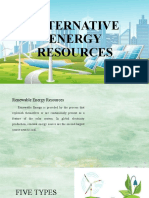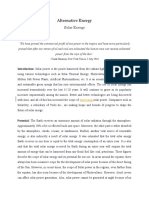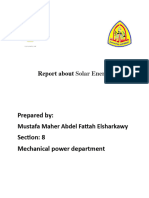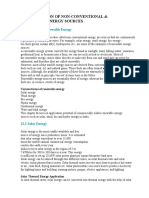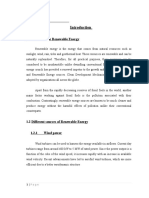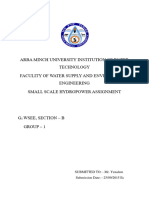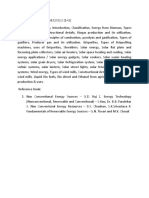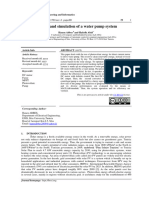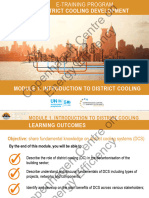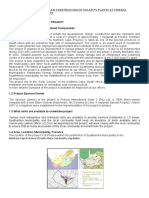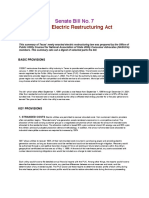Renewable Energy
Unit I: Renewable Energy Scenario: Solar Energy
Renewable energy
Renewable energy is energy derived from natural sources that are replenished at a higher rate than
they are consumed. Sunlight and wind, for example, are such sources that are constantly being
replenished.
Estimated Potential and Installed Capacity of Major Renewable Energy Technologies in India:
India stands 4th globally in Renewable Energy Installed Capacity (including Large Hydro),
4th in Wind Power capacity & 4th in Solar Power capacity (as per REN21 Renewables 2022
Global Status Report).
As of 31st August 2022, Renewable energy sources, including large hydropower, have a
combined installed capacity of 163 GW.
The following is the installed capacity for Renewables:
• Wind power: 41.2 GW
• Solar Power: 59.34 GW
• Biomass/Co-generation: 10.2 GW
• Small Hydro Power: 4.88 GW
• Waste To Energy: 0.47 GW
• Large Hydro: 46.85 GW
India has set a target to reduce the carbon intensity of the nation’s economy by less than 45%
by the end of the decade, achieve 50% cumulative electric power installed by 2030, and achieve
net-zero carbon emissions by 2070.
The top 10 Solar power companies in India
1. Tata Power Solar Systems Ltd.
2. Amplus Energy Solutions Private Ltd. ICOMM Tele Ltd.
3. Azure Power.
4. Moser Baer Photovoltaic Ltd.
5. Kotak Urja Pvt Ltd. HHV Solar Technologies Pvt Ltd.
6. EMMVEE.
7. Vikram Solar
8. Inter Solar System
DKTES Textile and Engineering Institute , Ichalkaranji (Electrical Engineering dept.) pg. 1
� Renewable Energy
Estimated Potential:
• 59 solar parks of aggregate capacity 40 GW have been approved in India
• Solar Parks in Pavagada (2 GW), Kurnool (1 GW) and Bhadla-II (648 MW) included
in top 5 operational solar parks of 7 GW capacity in the country.
• The world’s largest renewable energy park of 30 GW capacity solar-wind hybrid
project is under installation in Gujarat
• India offers a great opportunity for investments in RE sector; $196.98 bn worth of
projects underway in India
• Wind Energy has an off-shore target of 30 GW by 2030 with 3 potential sites identified
Advantages of non-renewable energy resources
Environmentally Friendly: Renewable energy sources are much cleaner than conventional
fossil fuels. They produce much fewer greenhouse gas emissions, the leading cause of global
warming.
Sustainable: Renewable energy sources are also sustainable, meaning they are infinitely
renewable. You can use them repeatedly without running out
Cost Effective: Renewable energy sources are much more cost-effective than traditional
sources, as they require little to no maintenance or fuel costs.
Reliable: Renewable sources are also highly reliable, as they are not affected by external
factors such as extreme weather
Renewable Jobs: Using renewable energy sources also creates jobs in the renewable energy
industry, which helps boost local economies. It also helps to reduce unemployment in rural
areas.
Reduced Dependence on Fossil Fuels: Renewable energy sources helps to reduce the
world’s dependence on fossil fuels, which are finite resources.
DKTES Textile and Engineering Institute , Ichalkaranji (Electrical Engineering dept.) pg. 2
� Renewable Energy
Disadvantages of Renewable Energy Sources
High Initial Investment: Renewable energy sources require a lot of money to set up. Solar,
wind, and hydroelectric power need large-scale infrastructure to harness the energy from
these sources. This infrastructure is expensive to build, maintain and upgrade.
Environmental Impact: While renewable sources of energy are much cleaner than
traditional sources of energy, they can still have an impact on the environment. For example,
the construction of hydroelectric dams can disrupt ecosystems, and the use of biofuels can
lead to deforestation.
Low Efficiency: Renewable energy sources often have lower efficiency than traditional
energy sources. For example, solar panels can only convert a small portion of the sun’s
energy into electricity.
Not Everywhere: Renewable energy sources are only available in some places. For example,
solar power is only available in abundant sunshine, and wind energy is only in areas with
strong winds.
Intermittency: Renewable energy sources are only sometimes available. For example, solar
power is only available during the day, and wind energy is only available when the wind
blows. A large amount of energy storage is needed to ensure a steady energy supply when
these sources are unavailable.
Difficult to Scale: Renewable energy sources are often challenging to scale up. For example,
solar energy requires large amounts of land to install solar panels, while wind energy requires
large parts of space for wind turbines.
What is solar energy?
Solar energy is the radiation from the Sun capable of producing heat, causing chemical
reactions, or generating electricity. The total amount of solar energy received on Earth is vastly
more than the world's current and anticipated energy requirements. If suitably harnessed, solar
energy has the potential to satisfy all future energy needs.
DKTES Textile and Engineering Institute , Ichalkaranji (Electrical Engineering dept.) pg. 3
� Renewable Energy
Direct Use of Solar Energy
• Water heating: Solar energy is used to replace electric heaters and gas as efficiency is
more with 15-30%.
• Heating of swimming pools: Solar blankets are used to keep the pool warm. The other
way is by using a solar water heater to keep the water warm.
• Cooking purposes: Solar cookers are used for cooking food. Solar energy is used to
heat, cook and pasteurize food. A solar cooker consists of an elevated heat sink such
that when food is placed in it, it gets cooked well.
• Drying purpose: Hot air is also required in industries such as leather, textiles,
chemicals, rubber, paper, pharmaceuticals etc. Solar Energy use for Drying
Advantages of solar energy:
1. Solar energy is a clean and renewable energy source.
2. Once a solar panel is installed, solar energy can be produced free of charge.
3. Solar energy will last forever whereas it is estimated that the world’s oil reserves will
last for 30 to 40 years.
4. Solar energy causes no pollution.
5. Solar cells make absolutely no noise at all. On the other hand, the giant machines
utilized for pumping oil are extremely noisy and therefore very impractical.
6. Very little maintenance is needed to keep solar cells running. There are no moving parts
in a solar cell which makes it impossible to really damage them.
7. In the long term, there can be a high return on investment due to the amount of free
energy a solar panel can produce, it is estimated that the average household will see
50% of their energy coming in from solar panels.
How is solar energy collected?
The most common devices used to collect solar energy and convert it to thermal energy are
flat-plate collectors. Another method of thermal energy conversion is found in solar ponds,
which are bodies of salt water designed to collect and store solar energy. Solar radiation may
also be converted directly into electricity by solar cells, or photovoltaic cells, or harnessed to
cook food in specially designed solar ovens, which typically concentrate sunlight from over a
wide area to a central point.
DKTES Textile and Engineering Institute , Ichalkaranji (Electrical Engineering dept.) pg. 4
� Renewable Energy
Solar collectors:
The main difference between a solar panel and solar collectors is that collectors collect solar
energy and convert it to a usable form of energy whereas a panel converts the light directly
into electricity with little to no conversion.
A solar collector is a device that absorbs the energy from the sun and uses it to heat a fluid,
often water. They are used for heating homes, buildings and water, or any type of fluid that
may meet your requirement.
A Solar Collector is very closely related to solar thermal energy and many of these devices are
used to harvest this form of energy. However, they can also be used to provide hot air which
may be required in chemical processes such as drying crops.
Types of Solar Collectors
1. Flat Plate Collectors
DKTES Textile and Engineering Institute , Ichalkaranji (Electrical Engineering dept.) pg. 5
� Renewable Energy
A typical flat-plate collector is a metal box with a glass or plastic cover (called glazing) on
top. Small tubes run through the box, carrying the water or other fluid, such as antifreeze, to
be heated. The tubes are mounted on a dark-colored metal absorber plate. Absorber plates are
commonly painted with "selective coatings," which absorb and retain heat better than ordinary
black paint. Absorber plates are usually made of metal—typically copper or aluminium—
because the metal is a good heat conductor. The sides and bottom of the collector are usually
insulated to minimize heat loss.
Sunlight passes through the glazing and strikes the absorber plate, which heats up, changing
solar energy into heat energy. The heat is transferred to liquid passing through pipes attached
to the absorber plate.
Flat-plate collectors heat the circulating fluid to a temperature considerably less than that of
the boiling point of water and are best suited to applications where the demand temperature is
30-70°C (86-158°F) and/or for applications that require heat during the winter months.
2. Evacuated Tube Collectors
DKTES Textile and Engineering Institute , Ichalkaranji (Electrical Engineering dept.) pg. 6
� Renewable Energy
The Evacuated tube collector consists of a number of rows of parallel transparent glass tubes
connected to a header pipe and which are used in place of the blackened heat absorbing plate
we saw in the previous flat plate collector. These glass tubes are cylindrical in shape. Therefore,
the angle of the sunlight is always perpendicular to the heat absorbing tubes which enables
these collectors to perform well even when sunlight is low such as when it is early in the
morning or late in the afternoon, or when shaded by clouds. Evacuated tube collectors are
particularly useful in areas with cold, cloudy wintry weathers. Evacuated tube collectors are
made up of a single or multiple rows of parallel, transparent glass tubes supported on a frame.
Each tube consists of a thick glass outer tube and a thinner glass inner tube, (called a “twin-
glass tube”) or a “thermos-flask tube” which is covered with a special coating that absorbs solar
energy but inhibits heat loss. The tubes are made of borosilicate or soda lime glass, which is
strong, resistant to high temperatures and has a high transmittance for solar irradiation.
Unlike flat panel collectors, evacuated tube collectors do not heat the water directly within the
tubes. Instead, air is removed or evacuated from the space between the two tubes, forming a
vacuum (hence the name evacuated tubes).
This vacuum acts as an insulator reducing any heat loss significantly to the surrounding
atmosphere either through convection or radiation making the collector much more efficient
than the internal insulating that flat plate collectors
Inside each glass tube, a flat or curved aluminium or copper fin is attached to a metal heat pipe
running through the inner tube. The fin is covered with a selective coating that transfers heat
to the fluid that is circulating through the pipe. This sealed copper heat pipe transfers the solar
heat via convection of its internal heat transfer fluid to a “hot bulb” that indirectly heats a
copper manifold within the header tank.
These copper pipes are all connected to a common manifold which is then connected to a
storage tank, thus heating the hot water during the day. The hot water can then be used at night
or the next day due to the insulating properties of the tank.
The insulation properties of the vacuum are so good that while the inner tube may be as high
as 100oC to 150oC, the outer tube is cooler to touch. This means that evacuated tube water
DKTES Textile and Engineering Institute , Ichalkaranji (Electrical Engineering dept.) pg. 7
� Renewable Energy
heaters can perform well and can heat water to fairly high temperatures even in cold weather
when flat plate collectors perform poorly due to heat loss.
3. Line Focus Collectors
A parabolic trough is a type of solar thermal collector that is straight in one dimension
and curved as a parabola in the other two, lined with a polished metal mirror.
The sunlight which enters the mirror parallel to its plane of symmetry is focused along
the focal line, where objects are positioned that are intended to be heated.
For other purposes, a tube containing a fluid runs the length of the trough at its focal
line. The sunlight is concentrated on the tube and the fluid heated to a high temperature
by the energy of the sunlight. The hot fluid can be piped to a heat engine, which uses
the heat energy to drive machinery, or to generate electricity. This solar energy collector
is the most common and best-known type of parabolic trough.
The trough is usually aligned on a north–south axis, and rotated to track the sun as it
moves across the sky each day. This increases the temperature of the fluid to some
400 °C.
As heat generation is large this type is not used for residential purpose but commonly
used in solar thermal power generation.
DKTES Textile and Engineering Institute , Ichalkaranji (Electrical Engineering dept.) pg. 8
� Renewable Energy
4. Point Focus Collectors
The parabolic solar dish is covered with many small mirror reflectors all around its
shape to help concentrate the thermal energy into a single focal point were the heat
absorber is located producing more overall thermal energy per square meter of dish.
These highly polished mirrors can reflect more than 90% of the sunlight that hits them
increasing the efficiency of the dish by more than 20% compared to the parabolic trough
collector. solar dish collector, some form of thermal receiver is required to convert the
focused beam of intense solar energy into heat. The solar receiver can be as simple as
a small evacuated tube or a more complex solar heat engine, such as a Stirling engine
generator. Due to the very high temperatures at the focal point, a thermal oil type fluid
is generally used instead of water inside the receiver, which transfers the intense heat
created by focusing the sunlight on the receiver. Like the trough collectors, solar dish
collectors can be used singly or linked together for larger industrial type applications.
At centre point solar panel also can be used to convert solar radiation in to electricity.
DKTES Textile and Engineering Institute , Ichalkaranji (Electrical Engineering dept.) pg. 9









